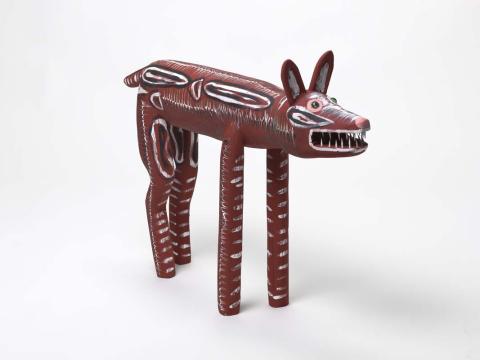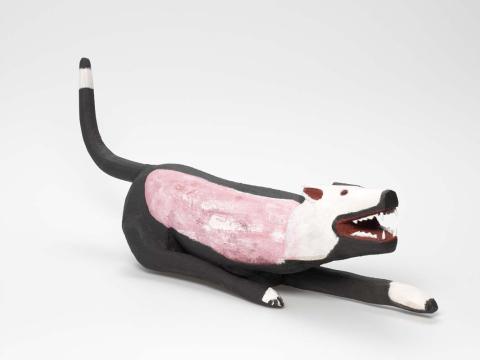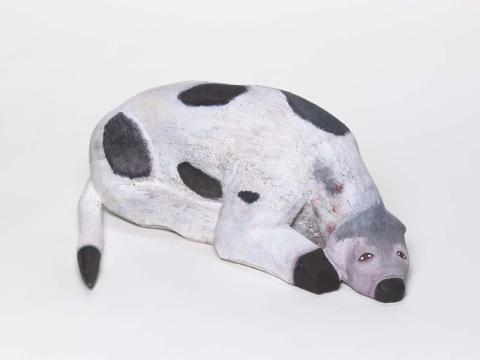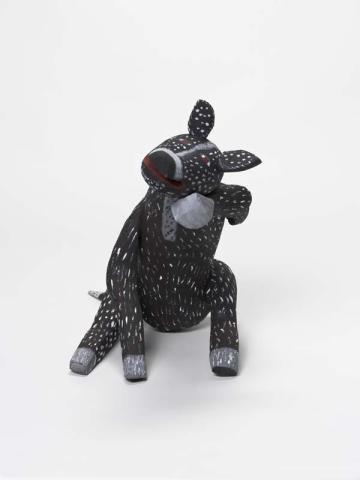Ku’ (camp dogs)
By Bruce Johnson McLean
Artlines | 4-2010 |
In almost all Aboriginal communities throughout Australia, dogs dominate the landscape: roaming the streets in packs and intimidating passers-by; individuals lying in the shade, seeking respite from the midday heat; and, in the evening, seeking out an ‘owner’ to feed them leftovers from the day’s meal. Wherever you go in these tiny communities, chances are that a dog will be nearby.
They come in all shapes and sizes. Often there are many ‘dingoes’ — or mixes of the native dog and any number of other breeds imported in past centuries — whose shiny golden coats now show distinctively Rottweiler-esque features. These mixed-up packs of misfits are given the collective colloquial name ‘camp dogs’ and, in the case of Aurukun, have the language name ‘Ku’.
These camp dogs are loved by their communities, with each individual having a larger-than-life personality, often well-known to most of the people in town. In places like Aurukun, however, dogs are seen not only as man’s best friend but also as physical manifestations of important ancestral heroes. One important Dingo Dreaming runs along the Knox River to the south of the town, with its major story place at Eeremangk, in the mouth of the river. After creating this river, the dingo turned into Nyiingkuchen, the freshwater shark. Today, the dingo is still revered as an animal possessing special qualities and dogs in general are acknowledged as culturally important — particularly as there are very few purebred dingoes remaining.
Wood-carving has been an important ceremonial art form in the Aurukun area from time immemorial. Sets of carved icons used in public ceremonies are now housed in Australia’s major museums. The recent renaissance of art in the community has centred on this traditional practice, with the woodcarvers of Aurukun becoming equally well known for their monumental ‘law poles’ — an embodiment of cultural laws, often used in increase ceremonies and funerary rites — and their often-quirky portrayals of people and animals, which inhabit the stories of the spirit world as well as the physical environment around the western Cape York community.
This group of dogs was originally produced over an extended period at the Wik and Kugu Art Centre in Aurukun, to be installed at the 2010 Cairns Indigenous Art Fair where they were stars of the event. As opposed to law poles, which are religious sculptures belonging to one of the five separate clans of Aurukun, camp dogs generally belong to everyone, allowing members of each clan to collaborate on this exciting and large-scale project.
This group of ku’ portrays a pack of the cheeky dogs from the remote Western Cape community, with the quirky edge that has made Aurukun carving so popular in the past decade. They run the gamut of canine emotions and expressions: the cheeky dog; the snivelling giggler; the overexcited ‘puppy’; the snarling menace; the long-legged, pretty-coated beauty; the well-fed alpha; the three-legged amputee; the old dog lying in the dust; the flea-ridden ear-scratcher; even the one that stands to attention like a cross between a Chihuahua and a wallaby — they are all here. Individually, they are compelling and strange creatures; together, they are a commanding pack to be reckoned with.
Feature image: A group of carved ku’ (camp dogs), 2021 / Collection: QAGOMA / © The artists / Photograph: M Sherwood, QAGOMA
Connected objects

Small ku' (camp dog) 2010
- WIKMUNEA, Keith - Creator

Ku' (Camp dog) 2010
- MARPOONDIN, David - Creator

Sitting ku' (camp dog) 2009
- MARPOONDIN, David - Creator

Ku' (Camp dog) 2010
- NAMPONAN, Garry - Creator

Ku' (Camp dog) 2009
- NAMPONAN, Garry - Creator

Ku' (Camp dog) 2010
- YUNKAPORTA, Roderick - Creator

Ku' (Camp dog) 2010
- BELL, Jack - Creator

Ku' (Camp dog) 2010
- KOOMEETA, Craig - Creator
Metadata, copyright and sharing information
About this story
- Subject



